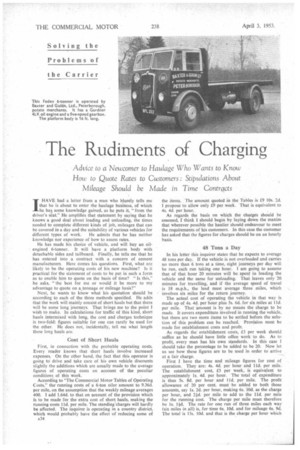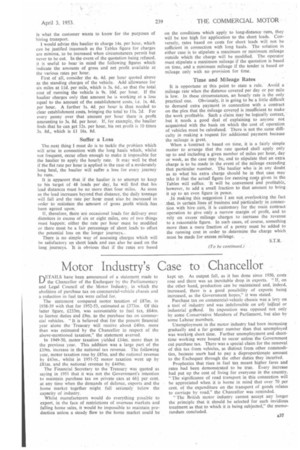The Rudiments of Charging
Page 60

Page 63

If you've noticed an error in this article please click here to report it so we can fix it.
Advice to a Newcomer to Haulage Who Wants to Know How to Quote Rates to Customers : Stipulations About Mileage Should be Made in Time Contracts IHAVE had a letter from a man who bluntly tells me that he is about to enter the haulage business, of which he has some knowledge gained, as he puts it, " from the driver s scat." He amplifies that statement by saying that he knows a good deal about loading and unloading, the times needed to complete different kinds of job, mileages that can be covered in a day and the suitability of various vehicles for
different types of work. He admits that he has neither knowledge nor experience of how to assess rates.
He has made his choice of vehicle, and will buy an oilengined 6-tanner. It will have a platform body with detachable sides and tailboard. Finally, he tells me that he has entered into a contract with a concern of cement manufacturers. Here comes his questions. First, what are likely to be the operating costs of his new machine? Is it practical for the statement of costs to be put in such a form as to enable him to quote on the basis of time? "Is this," he asks. " the best for me or would it be more to my advantage to quote on a.tonnage or mileage basis?"
Next, he wants to know what his quotation should be according to each of the three methods specified. He adds that the work will mainly consist of short hauls but that there will be some long journeys. That brings me to the point I wish to make. In calculations for traffic of this kind, short hauls intermixed with long, the cost and charges technique is two-fold: figures suitable for one can rarely be used for the other. He. does not, incidentally, tell me what length these long hauls are.
Cost of Short Hauls
First, in connection with the probable operating costs. Every reader knows that short hauls involve increased expenses. On the other hand, the fact that this operator is going to drive and take care of his own vehicle discounts slightly the additions which are usually made to the average figures of operating costs on account of the peculiar conditions of this work.
According to "The Commercial Motor Tables of Operating Costs." the running costs of a 6-ton oiler amount to 9.36d. per mile, on the assumption that the weekly mileage averages 400. I add 1.64d. to that on account of the provision which is to be made for the extra cost of short hauls, making the running costs 11d, per mile. The standing charges will hardly be affected. The inquirer is operating in a country district, which would probably have the effect of reducing some of
the items. The amount quoted in the Tables is £9 10s. 2d. I propose to allow only £9 per week. That is equivalent to 4s. 4d. per hour.
As regards the basis on which the charges should be assessed, I think I should begin by laying down the maxim that wherever possible the haulier should endeavour to meet the requirements of his customers. In this case the customer has asked that the figures for charges should be on an hourly basis.
48 Tons a Day
In his letter this inquirer states that he expects to average 48 tons per day. If the vehicle is not overloaded and carries no more than 6 tons at a time, eight journeys per day will be run. each run taking one hour. I am going to assume that of that hour 20 minutes will be spent in loading the vehicle and the same for unloading. That leaves only 20 minutes for travelling, and if the average speed of travel is 18 m.p.h., the lead must average three miles, which involves six miles for the return journey.
The actual cost of operating the vehicle in that way is made up of 4s. 4d. per hour plus 5s. 6d. for six miles at 1Id. per mile. That amount is by no means the charge to be made. It covers expenditure involved in running the vehicle, but there are two more items to he settled before the solution of this problem can be reached. Provision must be made for establishment costs and profit.
As regards the establishment costs, £3 per week should suffice as he should have little office work to do. As to profit, every man has his own standards. In this case I should take the percentage to be added to be 20. Now let us see how these figures are to be used in order to arrive at a fair charge.
First I have the time and mileage figures for cost of operation. They are: 4s. 4d. per hour and lid, per mile. The establishment cost, £3 per week, is equivalent to approximately Is. 4d. per hour. The total of expenditure is thus 5s. 8d. per hour and 11d, per mile. The profit allowance of 20 per cent. must be added to both those
amounts, say is. 2d. per hour, making 6s. 10d. as the charge per hour, and 2id. per mile to add to the lid, per mile
for the running cost. The charge per mile must therefore be ls. 1icl. The rate for one run of three miles each way (six miles in all) is, for time 6s. 10d. and for mileage 6s. 9d. The total is 13s, 10d. and that is the charge per hour which
is what the customer wants to know for the purposes of hiring transport.
I would advise this haulier tb charge 14s. per hour, which can be justified inasmuch as the Tables figure for charges are minima, to be increased when circumstances permit but never to be cut. in the event of the quotation being refused, it is useful to bear in mind the following figures which indicate the amounts of gross and net profit available at the various rates per hour.
First of all, consider the 4s. 4d. per hour quoted above as the standing charges of the vehicle. Add allowance for six miles at 11d, per mile, which is 5s. 6d., so that the total cost of running the vehicle is 9s. 10d. per hour. If the haulier charges only that amount he is working at a loss equal to the amount of the establishment costs, i.e. Is. 4d. per hour. A further Is. 4d. per hour is thus needed to clear establishment costs, bringing the total to 1 Is. 2d. For every penny over that amount per hour there is profit amounting to 3s. 8d. per hour. If, for example, the haulier finds that he can get 12s. per hour, his net profit is 10 times 3s. 8d., which is Li 16s. 8d.
Suffer a Loss
The next thing I must do is to tackle the problem which will arise in connection with the long hauls which, whilst not frequent, occur often enough to make it impossible for the haulier to apply the hourly rate. It may well be that if the flat rate per hour is applied in the case of a moderately long haul, the haulier will suffer a loss for every journey he runs.
It is apparent that if the haulier is to attempt to keep to his target of 48 loads per day, he will find that his lead distances must be no more than four miles. As soon as the lead increases beyond that distance, the daily tonnage will fall and the rate per hour must also be increased in order to maintain the arnount of gross profit which has been agreed upon.
If, therefore, there are occasional loads for delivery over distances in excess of six or eight miles, one of two things must happen; either the rate per hour must be modified or there must be a fair percentage of short leads to offset the potential loss on the longer journeys.
There is no simple way of assessing charges which will be satisfactory on short leads and can also be used on the long journeys. `It is obvious that if the rates are based on the conditions which apply to long-distance runs, they will be too high for application to the short leads. Conversely, rates based on costs for short leads will not be sufficient in connection with long hauls. The solution in either case is to stipulate a maximum or minimum mileage outside which the charge will be modified. The operator must stipulate a maximum mileage if the quotation is based on time, and a minimum mileage if the tender is based on mileage only with no provision for time.
Time and Mileage Rates
It is opportune at this point to state a rule. Avoid a mileage rate when the distance covered per day or per mile is low. In these circumstances, an hourly rate is the only practical one, Obviously, it is going to be a little difficult to demand extra payment in connection with a contract on the plea that the mileage covered is insufficient to make the work profitable. Such a claim may be logically correct, but it needs a good deal of explaining to anyone not acquainted with the basis on which the cost of operation of vehicles must be calculated. There is not the same difficulty in making a request for additional payment because the mileage is great.
When a 'Contract is based on time, it is a fairly simple matter to arrange that the rate quoted shall apply only up to and including a given number of miles per hour, day or week, as the case may be, and to stipulate that an extra charge is to be made in the event of the mileage exceeding that particular number. The haulier who is in any doubt as to what his extra charge should be in that case may take it that the actual figure for fanning costs given in the Tables will suffice. It will be convenient and profitable, however, to add a small fraction to that amount to bring it up to an even figure in pence.
..In making this suggestion I am not overlooking the fact that in certain lines of business and particularly in connection with hire cars, it is customary for the main contract operation to give only a narrow margin of profit, and to rely on excess mileage charges to increase the revenue to a reasonable figure. In such cases, of course, something more than a mere fraction of a penny must be added to the running cost in order to determine the charge which must be made for excess mileage. ,




























































































